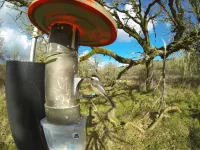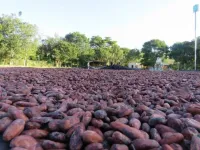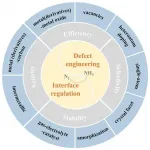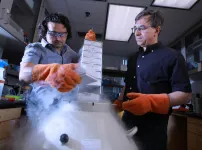(Press-News.org) CORVALLIS, Ore. - Oregon State University researchers have some good news for the well-meaning masses who place bird feeders in their yards: The small songbirds who visit the feeders seem unlikely to develop an unhealthy reliance on them.
"There's still much we don't know about how intentional feeding might induce changes in wild bird populations, but our study suggests that putting out food for small birds in winter will not lead to an increased dependence on human-provided food," said Jim Rivers, an animal ecologist with the OSU College of Forestry.
Findings from the research, which looked at black-capped chickadees outfitted with radio frequency identification tags, were published today in the Journal of Avian Biology.
Around the globe each year, hundreds of millions of people put out food for wildlife, including 50 million in the United States alone, driving a $4 billion industry based on food, feeders and other accessories. But the popular pastime has long raised concerns about making animals dependent on human-provided food - especially during wintertime and other parts of the annual cycle that require animals to expend a lot of energy.
"The extensive and widespread nature of people intentionally feeding wildlife can have unintended consequences for free-ranging animal populations, and those consequences are best documented in birds," Rivers said. "On the negative side, it can facilitate disease transmission, restructure local communities and alter migration behavior, for example. There's even evidence that it can lead to changes to birds' bill structure. On the other hand, it can also have positive effects, such as enhanced body condition, wintertime survival and reproductive output."
Bird feeding is especially popular in the northern latitudes, particularly during winter, when cold, stormy weather and minimal daylight reduce the time that birds have for locating natural foods. But not much is known, Rivers said, about whether birds become reliant on the feed their human friends toss out for them.
"The only manipulative experiment to test that, also using the black-capped chickadee, was 30 years ago," he said. "It found no reductions in apparent survival after removal of bird feeders that had provided supplemental food in winter for 25 years, leading to the conclusion that bird feeding did not promote feeder dependency."
Rivers and colleagues studied the feeder use habits of 67 black-capped chickadees subjected to one of three flight-feather-clipping treatments: heavy clipping, light clipping or, as the control, no clipping. Experimental removal of primary flight feathers is an established technique for altering wing loading and increasing the energy costs of flight, Rivers said.
The birds were tagged with RFID chips, and 21 bird feeders along a 3.2-kilometer riparian zone were filled with sunflower seeds and equipped with chip readers to measure feeder visits by tagged birds.
Scientists chose the chickadee because it is a small songbird (it weighs less than half an ounce) that frequents bird feeders during winter throughout its range; has high daily energy requirements; and typically takes one seed at each feeder visit, allowing for a clear measure of feeder visitation rate.
"It's an ideal species for evaluating how energetic challenges lead to behavioral changes in feeder use during winter," Rivers said. "Our study found that the experimentally handicapped chickadees, those experiencing elevated flight costs, did not increase their rates of visitation to the feeders."
Instead, feather-clipped birds actually decreased their feeder use for a couple of weeks - possibly to reduce exposure to predation - but after that used the feeders at levels similar to the unclipped control birds. The researchers looked at number of feeder visits, number of feeders used and timing of feeder visits and found little difference between clipped and non-clipped chickadees.
"Feather-clipped chickadees reducing their use of feeders relative to control birds suggests that foods in the environment - like seeds, berries and small invertebrates - were sufficiently available to compensate for increased flight costs and allowed them to cut back on feeder use," Rivers said. "It's clear that the chickadees in our study did not increase their visitation rates nor did they increase their reliance on supplemental feed during a period when they might have benefited from it the most."
INFORMATION:
Janel Lajoie and Lisa Ganio collaborated with Rivers on the research. Lajoie earned a master's degree from the OSU College of Forestry and Ganio leads the Department of Statistics in the OSU College of Science.
Funding the study were the Department of Forest Ecosystems and Society and the College of Forestry at Oregon State University, with research supplies donated by Global Harvest Foods, Kay Home Products and Perky?Pet, Inc.
New York, NY (June 28, 2021) - Patients with a type of blood cancer called multiple myeloma had a widely variable response to COVID-19 vaccines--in some cases, no detectable response--pointing to the need for antibody testing and precautions for these patients after vaccination, according to a study that will be published in Cancer Cell this week.
Mount Sinai researchers found that multiple myeloma patients mount variable and sometimes suboptimal responses after receiving the Pfizer-BioNTech or Moderna COVID-19 vaccines. Almost 16 percent of these patients developed no detectible antibodies after both vaccine doses. These findings may be relevant to other cancer patients undergoing treatment and to immunocompromised patients.
"This study ...
Did you know chocolate comes from cocoa beans grown in some of the most biodiverse tropical landscapes on the planet? The cocoa tree (Theobroma cacao) is farmed within biodiversity hotspots of West Africa, South America, and Southeast Asia. Cocoa was traditionally grown under a canopy of native trees that provided habitat for birds and other wildlife. However, pressure to increase cocoa production has pushed many farmers to clear forest and eliminate the shade trees on their farms.
An estimated 2-3 million hectares of tropical forest were converted to cocoa from 1988-2008 with severe consequences for biodiversity. Unsustainable cocoa monocultures (agricultural ...
Multi-business firms have flexibility advantages over single-business rivals because they have the option to redeploy resources across businesses. This flexibility, it has been assumed without empirical evidence, is purported to inspire quicker exits from markets.
A 2017 survey revealed that 70 percent of corporate executives expected to make at least one divestment in the subsequent two years, with the primary motive being strategic realignment of portfolios as non-core assets are shed. A large number of academic studies have established that parent firms tend ...
Imagine having feelings of distress and negativity at some point as you are going about your day. Then imagine feeling that way every day, for almost 21 days. Lesbian, gay, bisexual, transgender and queer youth don't have to imagine having negative feelings at some point throughout the day for an extended period of days. A new study from American University reveals just how pervasive emotional distress is related to stigma around sexual orientation.
"Although we know that LGBTQ youth experience bullying, discrimination, and microaggressions during adolescence, we don't know how prevalent these experiences ...
The electrochemical nitrogen reduction reaction (e-NRR) under ambient conditions is an emerging strategy to tackle the hydrogen- and energy-intensive processes entailed in industrial ammonia (NH3) synthesis via the traditional Haber-Bosch process. However, the e-NRR performance is currently impeded by the inherent inertness of N2 molecules, extremely slow kinetics, and overwhelming competition from the hydrogen evolution reaction (HER), all of which result in an unsatisfactory yield and ammonia selectivity (Faradaic efficiency, FE). To achieve a high-selectivity and high-performance NRR under ambient conditions, the rational design of efficient electrocatalysts is urgently required. Defect and interface engineering ...
A team of computer scientists at the USC Viterbi School of Engineering set out to develop new tools automate and organize social science data. What did they use as their data sets? Twitter posts from coastal capitals, New York City and Los Angeles.
The researchers found that they could identify similar tweets that do not have hashtags by using natural language processing and neural networks to create clusters of alike tweets. "It's using AI to create a map of similar tweets," says Mayank Kejriwal, a Research Assistant Professor in the USC Department of Industrial and Systems Engineering, and a Research Lead at the USC Information ...
Scientists at The University of Toledo discovered new movement in sperm that provides innovative avenues for diagnostics and therapeutic strategies for male infertility.
The research published in Nature Communications finds that the atypical centriole in the sperm neck acts as a transmission system that controls twitching in the head of the sperm, mechanically synchronizing the sperm tail movement to the new head movement.
The centriole has historically been considered a rigid structure that acts like a shock absorber.
"We think the atypical centriole in the sperm's neck is an evolutionary innovation whose function is to make your sperm move better," said Dr. Tomer Avidor-Reiss, professor of biological sciences in the UToledo College of Natural Sciences and Mathematics. "Reproductive ...
DALLAS, June 28, 2021 -- People who must spend $1,000 or more annually in out-of-pocket medical deductibles under their health care insurance plan were less likely to seek care in the ER for chest pain and less likely to be admitted to the hospital during these visits, compared to people who have health insurance plans with an annual deductible of $500 or less, according to new research published today in the American Heart Association's flagship journal Circulation.
Chest pain can occur when the heart muscle doesn't get enough oxygen-rich blood. It may feel like pressure or squeezing in the chest. The discomfort also can occur in the shoulders, arms, neck, jaw or back and may also feel like indigestion. Chest pain may be a symptom of an underlying heart problem, usually coronary heart disease ...
28 June 2021: The risk of cancer in children born as a result of fertility treatment has been found to be no greater than in the general population.
Results presented today at the 37th Annual Meeting of ESHRE from an 18-year median follow up study demonstrate that the overall chance of developing malignant disease did not increase in ART-conceived offspring. Details of the analysis are presented today online by Dr Mandy Spaan from the Amsterdam University Medical Center (UMC) and Netherlands Cancer Institute, Amsterdam, at the virtual Annual Meeting of ESHRE.
The ...
28 June 2021: Despite continuing controversies over its value in improving birth rates in IVF, testing embryos for their chromosomal content has become routine in many fertility clinics. Embryos with a normal complement of chromosomes (known as "euploid") are known to have a good chance of implanting in the uterus to become a pregnancy, while abnormal embryos (aneuploid) have no chance. Testing embryos for aneuploidy (known as PGT-A*) has so far required a sample single cell or several cells taken from the embryo by biopsy, and this too has raised fears over safety such that a search for non-invasive methods has arisen in recent years.
Now, a new study suggests that euploid embryos can be visually distinguished from ...



